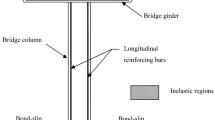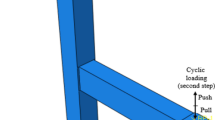Abstract
This paper aims to provide guidelines to select suitable element models and material models for steel and concrete to evaluate the nonlinear behavior of RC bridge pier. To achieve this objective, an existing two span (45.0 + 45.0 m) PSC box girder bridge with reinforced concrete circular pier has been considered to perform the nonlinear analyses. Two nonlinear element models, i.e., beam with hinges and distributed plasticity have been considered. Three material models for steel, i.e., Steel 01, Steel 02, Reinforcing steel and two material models for concrete, i.e., Concrete 01 and Concrete 02 have been considered. Overall, twelve models have been generated and nonlinear analyses have been performed on each model. Ultimate drift ratios and corresponding shear force values have been taken for comparison among the models. Mean and standard deviation values have been compared between beam with hinges and force-based distributed plasticity models. Force-based formulation allows plastic hinges to form at any location and account for axial–moment interaction by integrating the force–deformation response at sections along the length of the element. This behavior at a section is described by a fiber model. The strain softening behavior of concrete can cause localization problems in beam–column elements especially in reinforced concrete members carrying high gravity loads. In beam with hinges model, restricted plastic hinge lengths at the element ends have been adopted to maintain numerical accuracy and objectivity. From the analytical results, it is found that beam with hinges model is more efficient than force-based distributed plasticity model because of its less standard deviation, computational comfort and its accuracy in predicting the nonlinear responses of reinforced concrete (RC) column. Reinforcing steel model for steel is exclusively proposed for fiber sections and Concrete 01 material model is suggestible over Concrete 02 for concrete modelling because of its quicker convergence than Concrete 02 especially in nonlinear time history analyses.

















Similar content being viewed by others
References
Almutairi, A., Lu, J., Elgamal, A., & Mackie, K. (2019). MS Bridge: opensees pushover and earthquake analysis of multi span bridges-user manuaL. Los Angeles: University of California
Aviram, A., Mackie K. R., & Stojadinović, B. (2008). Guidelines for nonlinear analysis of bridge structures in California. PEER Report No. 2008/03, Pacific Earthquake Engineering Research Centre. Berkeley: University of California
Baker, A. L. L. (1956). Ultimate Load Theory Applied to the Design of Reinforced and Prestressed Concrete Frames (p. 91). London: Concrete Publications Ltd.
Banda, S. C., & Kumar, G. R. (2022). Seismic evaluation of RC bridge pier using analytical fragility curves. Innov Infrastruct Solutions, 7(4), 276. https://doi.org/10.1007/s41062-022-00874-0
Berry, M. P., & Eberhard, M. O. (2008). Performance modelling strategies of Modern Reinforced Concrete Bridge Columns. PEER Report No. 2007/07, Pacific Earthquake Engineering Research Centre. Berkeley: University of California
Berry, M. P., Lehman, D. E., & Lowes, L. N. (2008). Lumped-plasticity models for performance simulation of bridge columns. ACI Structural Journal, 105, 270–279
Bing, Li., Park, R., & Tanaka, H. (2001). Stress-strain behavior of high-strength concrete confined by ultra-high- and normal-strength transverse reinforcements. ACI Structural Journal, 98(3), 395–406.
Bruun, E. P. G., Kuan, A., Proestos, G. T., Bentz, E. C., & Collins, M. P. (2018). Advanced nonlinear finite element modelling of reinforced concrete bridge piers. Maintenance, Safety, Risk, Management and Life-Cycle Performance of Bridges. https://doi.org/10.1201/9781315189390-167
Caltrans. (2019). Caltrans Seismic Design Criteria version 20. Sacramento, California: California Department of Transportation.
Corley, W. G. (1966). Rotational capacity of reinforced concrete beams. Journal of Structural Division, ASCE, 92(ST5), 121–146.
Cusson, D., & Paultre, P. (1993). High-strength concrete columns confined by rectangular ties. ASCE Structural Journal, American Society of Civil Engineers, 120(3), 783–804.
Di Re, P., Bernardini, D., Ruta, D., & Paolone, A. (2022). A simple numerical approach for the pushover analysis of slender cantilever bridge piers taking into account geometric nonlinearity. Asian Journal of Civil Engineering, 23(4), 455–469. https://doi.org/10.1007/s42107-022-00433-z
Esmaeily-Ghasemabadi, A., & Xiao Y. (2002). Seismic Behavior of Bridge Columns Subjected to Various Loading Patterns. PEER Report No. 2002/15, Pacific Earthquake Engineering Research Center. Berkeley: University of California
Fafitis, A., & Shah, S. P. (1985). Predictions of ultimate behavior of confined columns subjected to large deformations. Journal of the American Concrete Institute, 82(4), 423–433.
Feng, Y., Kowalsky, M. J., & Nau, J. M. (2014). Fiber-based modeling of circular reinforced concrete bridge columns. Journal of Earthquake Engineering, 18(5), 714–734. https://doi.org/10.1080/13632469.2014.904254
Gao, Y., & Lin, L. (2018). Effects of modelling parameters on the seismic analysis of bridges. International Journal of Computational Methods and Experimental Measurements, 6(3), 868–879. https://doi.org/10.2495/CMEM-V6-N5-868-879
Li, S., Zhai, C.-H., & Xie, L.-L. (2012). Evaluation of displacement-based, force-based and plastic hinge elements for structural non-linear static analysis. Advances in Structural Engineering, 15(3), 477–488. https://doi.org/10.1260/1369-4332.15.3.477
Lu, J., Elgamal, A., & Mackie, K. R. (2015). Parametric Study of Ordinary Standard Bridges using Opensees and CSI Bridge, Report CA 16–2419. University of California, San Diego, Department of Structural Engineering Structural Systems Research Project, Submitted to the California department of transportation (Caltrans)
Mackie, K. R., & Scott, M. H. (2019). Implementation of nonlinear elements for seismic response analysis of bridges. Practice Periodical on Structural Design and Construction, 24(3), 04019011. https://doi.org/10.1061/(ASCE)SC.1943-5576.0000420
Mander, J. B., Priestley, M. J. N., & Park, R. (1984). Seismic Design of Bridge Piers, Res. Rep. Department of Civil Engineering (pp. 84–92). Christchurch, New Zealand: University of Canterbury.
Mander, J. B., Priestley, M. J. N., & Park, R. (1988). Theoretical stress-strain model for confined concrete. Journal of Structural Engineering, 114(8), 1804–1826. https://doi.org/10.1061/(ASCE)0733-9445(1988)114:8(1804)
Mazzoni, S., McKenna, F., Scott, M. H., & Fenves, G. L. (2006). Open System for Earthquake Engineering Simulation User Command-Language Manual. University of California, Berkeley, USA.
Panagiotakos, T. B., & Fardis, M. N. (2001). Deformations of reinforced concrete members at yielding and ultimate. ACI Structural Journal, 98, 135–148
Park, R., & Paulay, T. (1975). Reinforced Concrete Structures. USA: John Wiley and Sons.
Paulay, T., & Priestley, M. (1992). Seismic design of reinforced concrete and masonry buildings (p. 767). NY: Wiley
Pozo, J. D., Hube, M. A., & Kurama, Y. C. (2022). Effective nonlinear simulations of RC columns with force-based elements. Journal of Earthquake Engineering. https://doi.org/10.1080/13632469.2021.2001395
Priestley, M. J. N., & Park, R. (1987). Strength and ductility of concrete bridge columns under seismic loading. ACI Structural Journal, 84(1), 61–76.
Rahai, A. R., & Nafari, S. F. (2013). A comparison between lumped and distributed plasticity approaches in the pushover analysis results of a pc frame bridge. International Journal of Civil Engineering, 11(4), 9.
Richart, F. E., Brandtzaeg, A., & Brown, R. L. (1928). A study of the failure of concrete under combined compressive stresses. University of Illinois Engineering Experiment Station, Bulletin, 26(12), 1–105.
Saatcioglu, M., & Razvi, S. (1992). Strength and ductility of confined concrete. ASCE Journal of Structural Engineering, 118(6), 590–1607.
Scott, M. H., & Fenves, G. L. (2006). Plastic hinge integration methods for force-based beam-column elements. Journal of Structural Engineering, 132(2), 244–252. https://doi.org/10.1061/(ASCE)0733-9445(2006)132:2(244)
Sheikh, S. A., & Uzumeri, S. M. (1982). Analytical model for concrete confinement in tied columns. Journal of the Structural Division, ASCE, 108(ST12), 2703–2722.
Spacone, E., Filippou, F. C., & Taucer, F. F. (1996a). FIBRE BEAM-COLUMN MODEL FOR NON-LINEAR ANALYSIS OF R/C FRAMES: PART I FORMULATION. Earthquake Engineering & Structural Dynamics, 25(7), 711–725.
Spacone, E., Filippou, F. C., & Taucer, F. F. (1996b). FIBRE BEAM-COLUMN MODEL FOR NON-LINEAR ANALYSIS OF R/C FRAMES: PART II. APPLICATIONS. Earthquake Engineering & Structural Dynamics, 25(7), 727–742.
Yong, Y.-K., Nour, M. G., & Nawy, E. G. (1988). Behavior of laterally confined high-strength concrete under axial loads. Journal of Structural Engineering, ASCE, 114(2), 332–351.
Yu-Ping, S., & Sakino, K. (1993). Experimental study on ductility improvement method for reinforced concrete columns using high-strength materials. Proceedings, Japan Concrete Institute, 15(2), 719–724.
Zendaoui, A., Kadid, A., & Yahiaoui, D. (2016). Comparison of different numerical models of RC elements for predicting the seismic performance of structures. International Journal of Concrete Structures and Materials, 10(4), 461–478. https://doi.org/10.1007/s40069-016-0170-7
Funding
The authors declare that no funds, grants, or other support were received during the preparation of this manuscript.
Author information
Authors and Affiliations
Corresponding author
Ethics declarations
Conflict of interest
On behalf of all the authors, the corresponding author states that there is no conflict of interest.
Additional information
Publisher's Note
Springer Nature remains neutral with regard to jurisdictional claims in published maps and institutional affiliations.
Rights and permissions
Springer Nature or its licensor holds exclusive rights to this article under a publishing agreement with the author(s) or other rightsholder(s); author self-archiving of the accepted manuscript version of this article is solely governed by the terms of such publishing agreement and applicable law.
About this article
Cite this article
Banda, S.C., Kumar, G.R. A comparative study of different numerical element and material models to study the nonlinear responses of RC bridge pier. Asian J Civ Eng 23, 1305–1320 (2022). https://doi.org/10.1007/s42107-022-00486-0
Received:
Accepted:
Published:
Issue Date:
DOI: https://doi.org/10.1007/s42107-022-00486-0




